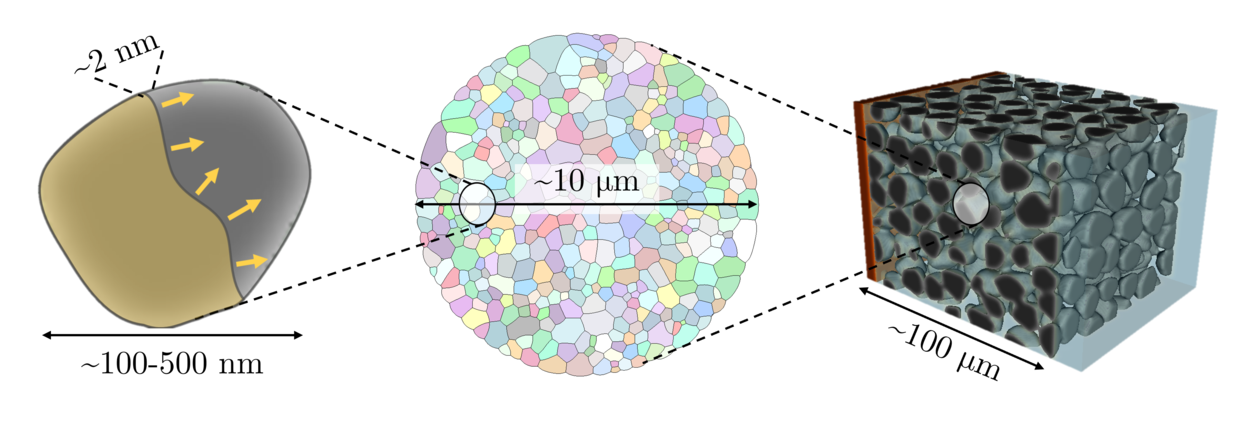Dr. Simon Daubner, M.Sc.
- Gruppenleiter
- simon daubner ∂does-not-exist.kit edu
Straße am Forum 7
76131 Karlsruhe
Research

My research interests cover
- Modeling of battery materials including
- Multi-physics on nano- to micro-scales such as phase transformations, chemical diffusion, elastic deformations and electrochemical reactions;
- Scale bridging using the multiphase-field method as a link between atomistic (DFT) and coarse-grained continuum models (Newman model, P2D approaches);
- Model reduction and homogenization approaches e.g. calculation of effective transport properties of polycrystalline or nanoporous battery particles as input for P2D models.
Most of my research has been done within the POLiS Cluster of Excellence and is focused on post-lithium systems. However, the modeling of intercalation materials is equally relevant for state-of-the-art lithium-ion batteries and novel electrode materials. The multiphase-field method can be used to model phase transformations and charge ordering during battery charging and discharging. Furthermore, it can be used to parametrize polycrystalline agglomerates, which are often found at the battery particle level. The aim of my research is the extension of existing modeling approaches to investigate and morphologically optimize promising electrode materials for lithium and post-lithium batteries. Specifically, this encompasses the
- Extension of existing concepts of the smooth boundary method to include electrochemical surface reactions on arbitrary shapes and for polycrystalline agglomerates;
- incorporation of fully anisotropic material properties, i.e. extension of the diffusion equation implementation to account for an anisotropic diffusion tensor;
- Create close link to DFT to feed phase-field simulations with data from atomic scales;
- Material-specific intercalation studies for NMC, LFP and sodium layered oxides.
Short CV
Simon Daubner Studied theoretical mechanical engineering with a focus on computational methods and numerics at the Karlsruhe Institute of Technology (KIT). His master studies were accompanied by an exchange semester at the KTH in Stockholm. Since 2019, he has been working on the modelling and simulation of battery materials using the multiphase-field method at KIT as part of his PhD studies. Phase transformations in energy materials and coupling simulation methods across scales are his main interests and led to a research stay at MIT in 2022. He is co-group leader of the microstructure mechanics group at the IAM-MMS.
Publications
Daubner, S.; Weichel, M.; Reder, M.; Schneider, D.; Huang, Q.; Cohen, A. E.; Bazant, M. Z.; Nestler, B.
2025. npj Computational Materials, 11 (1), 211. doi:10.1038/s41524-025-01707-1
Hoffrogge, P. W.; Daubner, S.; Schneider, D.; Nestler, B.; Zhou, B.; Eiken, J.
2025. Modelling and Simulation in Materials Science and Engineering, 33 (1), Art.-Nr.: 015001. doi:10.1088/1361-651X/ad8d6f
Daubner, S.; Nestler, B.
2024. Journal of The Electrochemical Society, 171 (12), Article no: 120514. doi:10.1149/1945-7111/ad9a07
Hoffrogge, P. W.; Daubner, S.; Schneider, D.; Nestler, B.; Zhou, B.; Eiken, J.
2024. Modelling and Simulation in Materials Science and Engineering
Huang, Q.; Daubner, S.; Schneider, D.; Zheng, X.; Liu, S.; Du, Y.; Nestler, B.
2024. Electrochimica Acta, 495, Art.-Nr.: 144471. doi:10.1016/j.electacta.2024.144471
Daubner, S.; Dillenz, M.; Pfeiffer, L. F.; Gauckler, C.; Rosin, M.; Burgard, N.; Martin, J.; Axmann, P.; Sotoudeh, M.; Groß, A.; Schneider, D.; Nestler, B.
2024. npj Computational Materials, 10 (1), Art.-Nr.: 75. doi:10.1038/s41524-024-01258-x
Daubner, S.
2023, Dezember 1. Karlsruher Institut für Technologie (KIT). doi:10.5445/IR/1000164858
Daubner, S.; Weichel, M.; Hoffrogge, P. W.; Schneider, D.; Nestler, B.
2023. Batteries, 9 (6), Art.Nr.: 310. doi:10.3390/batteries9060310
Huang, Q.; Daubner, S.; Zhang, S.; Schneider, D.; Nestler, B.; Mao, H.; Liu, S.; Du, Y.
2023. Computational Materials Science, 220, Art.-Nr.: 112047. doi:10.1016/j.commatsci.2023.112047
Daubner, S.; Hoffrogge, P. W.; Minar, M.; Nestler, B.
2023. Computational Materials Science, 219, Art.-Nr.: 111995. doi:10.1016/j.commatsci.2022.111995
Daubner, S.; Reder, M.; Prajapati, N.; Schneider, D.; Nestler, B.
2023. Journal of Computational Science, 66, Art.-Nr.: 101930. doi:10.1016/j.jocs.2022.101930
Nieschlag, J.; Ruhland, P.; Daubner, S.; Koch, S.-F.; Fleischer, J.
2018. Production Engineering, 12 (2), 239–247. doi:10.1007/s11740-017-0788-6
Daubner, S.; Weichel, M.; Schneider, D.; Nestler, B.
2022. Electrochimica Acta, 421, Art.Nr. 140516. doi:10.1016/j.electacta.2022.140516
Santoki, J.; Daubner, S.; Schneider, D.; Kamlah, M.; Nestler, B.
2021. Modelling and simulation in materials science and engineering, 29 (6), Art.Nr. 065010. doi:10.1088/1361-651X/ac11bc
Liu, X.; Schneider, D.; Daubner, S.; Nestler, B.
2021. Computer methods in applied mechanics and engineering, 381, Article: 113842. doi:10.1016/j.cma.2021.113842
Reder, M.; Schneider, D.; Wang, F.; Daubner, S.; Nestler, B.
2021. International Journal for Numerical Methods in Fluids, 93 (8), 2486–2507. doi:10.1002/fld.4984
Daubner, S.; Kubendran Amos, P. G.; Schoof, E.; Santoki, J.; Schneider, D.; Nestler, B.
2021. Physical review materials, 5 (3), Article no: 035406. doi:10.1103/PhysRevMaterials.5.035406

